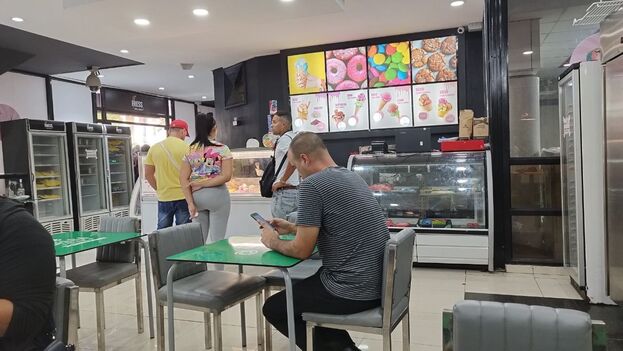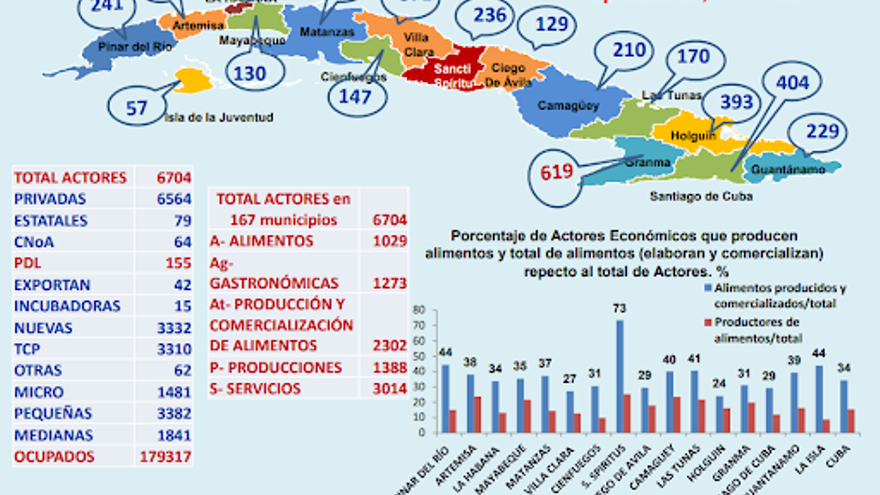
![]() 14ymedio, Madrid, 7 March 2023 — The Grupo de Administración Empresarial S.A. (Gaesa), the all-powerful conglomerate belonging to the Revolutionary Armed Forces, has been deliberately drowning the private sector in Cuba since 2016, and the SME law (micro, small and medium enterprises), promulgated in 2021, is only a “false opening” to attract foreign investment and facilitate a new rapprochement with the United States, a “thaw 2.0.”.
14ymedio, Madrid, 7 March 2023 — The Grupo de Administración Empresarial S.A. (Gaesa), the all-powerful conglomerate belonging to the Revolutionary Armed Forces, has been deliberately drowning the private sector in Cuba since 2016, and the SME law (micro, small and medium enterprises), promulgated in 2021, is only a “false opening” to attract foreign investment and facilitate a new rapprochement with the United States, a “thaw 2.0.”.
Those are the main conclusions of a report made public this Monday by the organization Cuba Siglo 21 [Cuba 21st Century], signed by the Cuban economist and consultant Emilio Morales, founder of the Havana Consulting Group, and made with the help of the Cuban Observatory of Citizen Audit and independent journalists of the Island.
With the title “Entrepreneurship in Cuba Suffocated by Gaesa,” the research shows how, after the economic opening began on the Island in 2011, when Fidel Castro had withdrawn from power and his brother Raúl governed, the private sector had an unprecedented boom between 2013 and 2016.
It was at that time, even in the midst of the thaw between Cuba and the United States headed by President Barack Obama, that Gaesa, then chaired by Raúl Castro’s former son-in-law, Luis Alberto Rodríguez López-Calleja — who died in Havana on July 1, 2022 — began what the Miami-based organization calls a “ruthless offensive” to “stop the largest citizen entrepreneurship movement that had occurred in recent decades.”
“The power and strength achieved by the movement of entrepreneurs, born in the heat of the reforms implemented in 2011, and the impact of the thaw were so strong, that even with the limitations allowed, in the period 2010-2016 there was a real boom in the non-state sector throughout the Island, which gave rise to a powerful middle class,” says the text. It pointed out that “the market showed the creation and consolidation of a very successful business structure made up of thousands of businesses in various modalities, most of them with their own brand.”
Thus, the report continues, Gaesa “began to resent the strong competition coming from the entrepreneurial sector,” for example in tourism. In just seven years, the lodging capacity of private individuals grew 268% compared to the “poor growth” of 3% of the state sector. “The CEO of Gaesa [López-Calleja] understood that the situation was getting out of control in an accelerated way, so this movement of citizen entrepreneurship had to be stopped categorically.”
Beginning in 2016, the document recalls, “no more licenses were issued to people for self-employment. The creation of new non-agricultural cooperatives (CNAs) was also stopped, even eliminating several of them and limiting the scope of action for those that remained.” In the following years, the regime continued to impose penalties on the private sector, decreasing the number of methods of self-employment and restricting the maximum wage, which could not exceed more than three times the minimum wage. Business licenses would be limited to a single activity per entrepreneur, and restaurant owners could operate in only one province or taxes would increase.
“Under these conditions, entrepreneurs saw the possibility of investing in their own country exhausted, so a strong movement began to export capital and go outside to look for new investment opportunities abroad,” the report details. “At the same time, the business of buying merchandise abroad to resell it in the informal market increases. This meant that the volume of dollars that left the country from the hand of the entrepreneurs was higher than the volume that the Government attracted as foreign investment.”
The devaluation of the Cuban convertible peso (CUC), which began to be quoted in the informal market at 50 pesos, caused people to prefer to buy the CUC “on the left” rather than at the exchange houses or banks, where they gave 25 pesos per CUC. This, the document asserts, “brought heavy losses for Gaesa, by exhausting the inventories of its stores faster and collecting CUCs and not dollars,” and it “meant that they ran out of liquidity to pay their debts with suppliers, many of whom would no longer sell to the Island.”
Faced with this reality, in the second half of 2019, Miguel Díaz-Canel announced two measures that, “far from achieving the effect of alleviating the country’s financial crisis, quickly led it towards an inflationary wave”: a wage increase without productive support, and price controls in both the state and private sectors. And the text continues: “This situation put the country at the gates of an inflationary powder keg.”
To combat the problem, the State did nothing but start a process of dollarization of the economy that exacerbated the problems even more. The COVID-19 pandemic, which the Cuban government is constantly using along with the US blockade to justify the crisis, only put the “headstone” on the island’s economy, in the words of the report.

This would create a kind of entrepreneurial middle class, “with the discreet capital of the oligarchy and its phantom companies,” the dossier argues, that Cuba’s own “agents of influence” in the United States would try to promote and sell to the Office of Foreign Assets Control (OFAC) of the Treasury Department as “legitimate private account holders and entrepreneurs” to allow them commercial, financial and credit transactions with the United States and the European Union. In this regard, they give as an example the mysterious financial company Orbit, which is already working with Western Union on the resumption of remittances to Cuba.
The strength of the arguments in Morales’ report lies in the data. The 6,161 SMEs registered on the Island at the beginning of 2023 represent only 1% of the number of entrepreneurs in 2016.
In that year, Cuba Siglo 21 points out, there were more than 500,000 Cubans with a self-employed work license, which in total generated more than 3 billion dollars. The debacle was progressive: “The obstruction to the reforms in 2016 removed some 80,000 self-employed people from the market. Subsequently, the pandemic and the monetary Ordering Task* caused more than 139,000 entrepreneurs to hand over their licenses or close their businesses. The country has lost two-thirds of this labor force because the State, which now boasts of creating SMEs that do not represent even 1% of those businesses, has since applied deliberate policies to repress them through prosecutors and police (the most successful often ended up in jail). A considerable part has emigrated, convinced that there is no future in Cuba.”
Against the possibility of what it calls “thaw 2.0,” the report also alleges that the Obama Administration’s rapprochement with the Island only benefited the “oligarchy” of the regime when 42 billion dollars of its foreign debt was forgiven, allowing them to obtain new lines of credit, increasing the tourist flow, using resources to build hotels and acquiring military equipment for repression.
“Pretending to draw up a policy of engagement with the aim of empowering the Cuban people and trying to promote a private sector that does not exist is to reiterate the errors of the first thaw,” says Cuba Siglo 21, because “concessions were made without reclaiming those that should have materialized, first or in parallel, on the Cuban side.”
The report concludes: “If the Cuban dictatorship on the Island and the Cuban exiles in the world have proven anything, it’s that without freedom there is no progress.”
*The Ordering Task [Tarea Ordenamiento]is a collection of measures that include eliminating the Cuban Convertible Peso (CUC), leaving the Cuban peso as the only national currency, raising prices, raising salaries (but not as much as prices), opening stores that take payment only in hard currency, which must be in the form of specially issued pre-paid debit cards, and a broad range of other measures targeted to different elements of the Cuban economy.
Translated by Regina Anavy
____________
COLLABORATE WITH OUR WORK: The 14ymedio team is committed to practicing serious journalism that reflects Cuba’s reality in all its depth. Thank you for joining us on this long journey. We invite you to continue supporting us by becoming a member of 14ymedio now. Together we can continue transforming journalism in Cuba.
